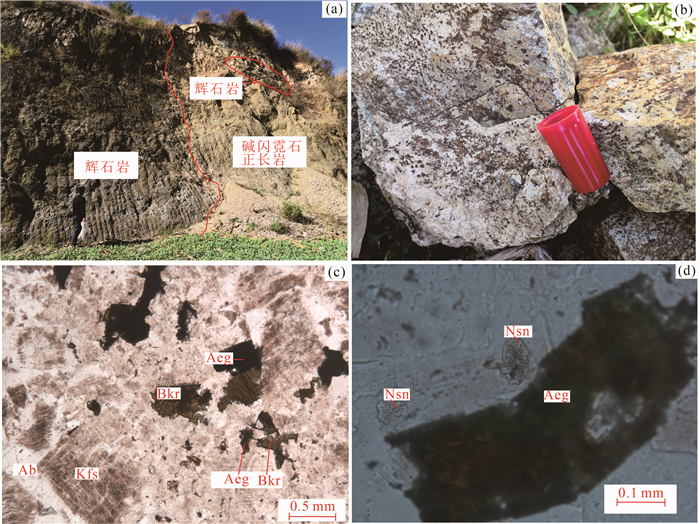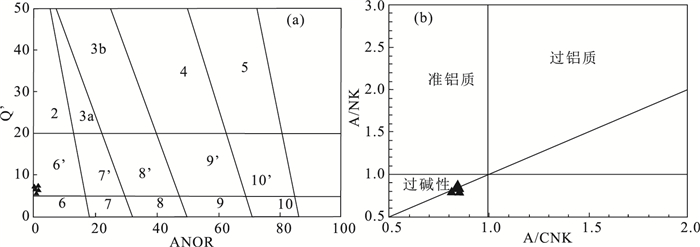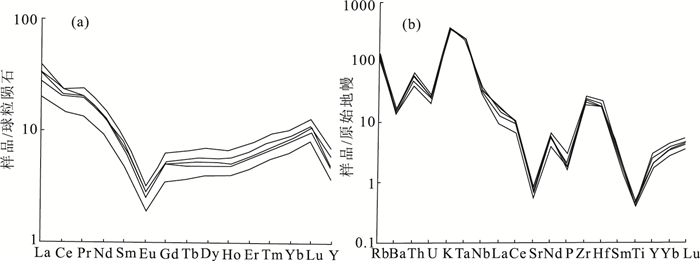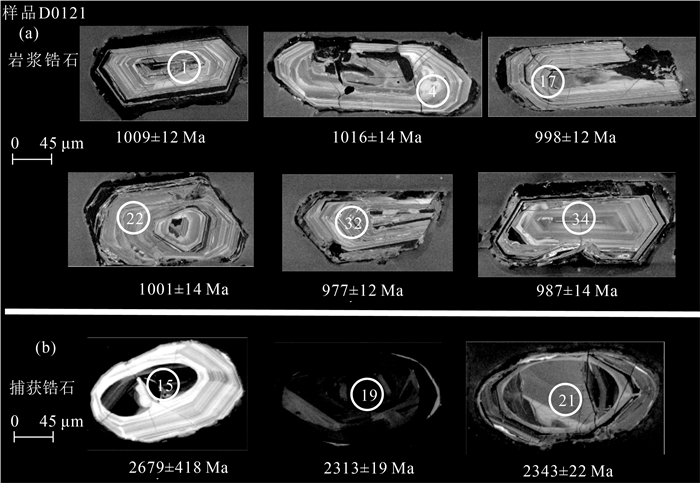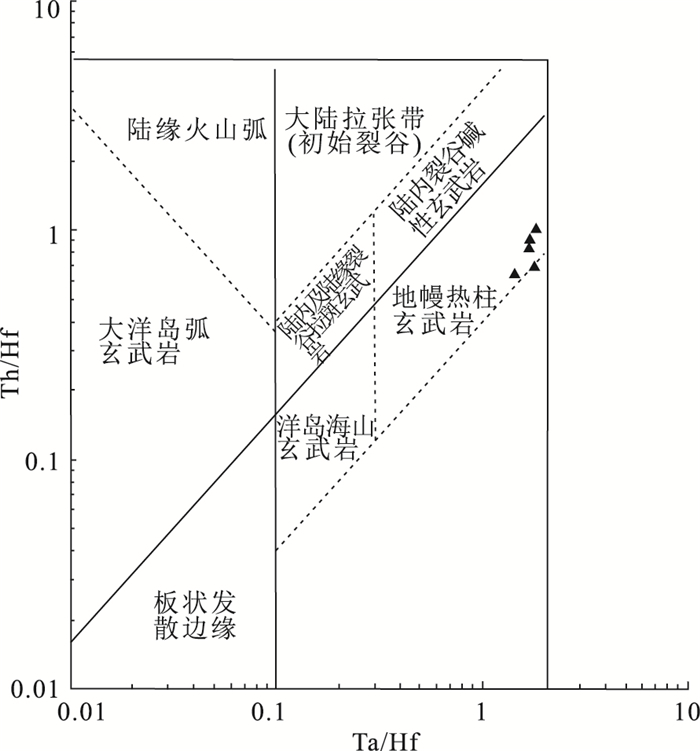The discovery of Late Mesoproterozoic alkali hornblende-aegirite syenite in E'shan area of central Yunnan and its constraints on Greenwell orogeny
-
摘要:
碱性岩通常形成于岩石圈拉张环境,其源于深部地幔物质的部分熔融,是深部地球动力学过程在地壳中的记录,也是探究地球深部物质组成、动力学过程及物理化学环境的良好对象。1:5万区域地质调查在峨山县甸中地区新发现一个正长岩岩体,岩性为碱闪霓石正长岩。系统的研究表明,碱闪霓石正长岩富硅(SiO2=67.40%~67.79%)、富碱(Na2O+K2O=12.50%~12.73%)、贫镁(MgO=0.10%~0.28%),K2O/Na2O=0.75~0.80,属一套钠质碱性岩系列(大西洋型)。岩石富集K、Rb等大离子亲石元素及Ta、Zr、Hf等高场强元素,而亏损Ti、P、U等高场强元素及Sr、Ba等大离子亲石元素。稀土元素配分曲线也较特殊,轻稀土元素向右陡倾,(La/Sm)N=3.61~4.79,重稀土元素向左缓倾,(Gd/Yb)N=0.53~0.62;具有中等程度的负Eu异常及弱负Ce异常,δEu=0.41~0.43,δCe=0.74~0.88,暗示岩浆可能形成于较高的氧逸度环境,总体上具有亏损中稀土元素的特点。LA-ICP-MS锆石U-Pb年龄为1007±10 Ma(MSWD=2.3,n=21),属中元古代末期,为扬子板块上已知形成时代最早的碱性岩体,限定了滇中地区格林威尔造山运动结束的时限。在Th/Hf-Ta/Hf图解上,样品均落入地幔热柱玄武岩区,暗示该碱性岩体可能为地幔柱成因,岩浆基本上未受到陆壳物质的混染,主体上可能属下地幔石榴子石橄榄岩的低程度部分熔融的产物;岩浆上升过程中可能与上地幔尖晶石橄榄岩发生了同化混染,重稀土元素含量快速升高;亏损中稀土元素、富Nb等特点暗示尖晶石地幔橄榄岩可能经历过俯冲流体的交代及中等程度的部分熔融。本次发现的碱闪霓石正长岩体应是格林威尔造山挤压作用向伸展作用转变的产物。
Abstract:Alkaline rocks are usually formed in the lithosphere stretching environment, which is derived from the partial melting of deep mantle material.As a record of deep geodynamic processes in the earth's crust, it is a good exploration of the deep matter composition, dynamic process and physical and chemical environment of the earth. In the 1:50000 regional geological survey, a syenite rock mass was newly discovered in the Dianzhong area of E'shan County, and its lithology is alkali homblende-aegirite-syenite.Systematic studies show that alkali hornblende-aegirite syenite rich in silicon (SiO2=67.40%~67.79%) and alkali (Na2O+K2O=12.50%~12.73%), depleted in magnesium (MgO=0.10%~0.28%) and K2O/Na2O=0.75~0.80, is a set of sodium alkaline rock series (Atlantic type).It is rich in large ion lithophile elements such as K and Rb, and high field strength elements such as Ta, Zr, and Hf, while depleted in high field strength elements such as Ti, P and U as well as large ion lithophile element, such as Sr, Ba.The rare earth distribution curve is also special, the light rare earth element is steeply inclined to the right, (La/Sm) N=3.61~4.79, and the heavy rare earth element is gently inclined to the left, (Ga/Yb) N=0.53~0.62.The moderately negative Eu anomaly and weak negative Ce anomaly (δEu=0.41~0.43, δCe=0.74~0.88) suggest that the magma may be formed in a higher oxygen fugacity environment and generally has the characteristics of depleted middle rare earth elements.LA-ICP-MS zircon U-Pb age is 1007±10 Ma (MSWD=2.3, n=21), which belongs to the end of the Middle Proterozoic.It is the earliest alkaline pluton formed on the Yangtze plate, which defines the time limit for the end of the Greenville Orogenic Movement in Central Yunnan Province.On the Th/Hf-Ta/Hf diagram, the samples fell into the "Mantle Hot Pillar Basalt" area, suggesting that the pluton might be the cause of the mantle plume, indicating that the magma is basically not contaminated by the continental crust, and the pluton might be the product of low partial melting of lower mantle garnet peridotite.During magma rise, it might be assimilated and mixed with the upper mantle spinel peridotite, and the content of heavy rare earth elements increases rapidly.The characteristics of depleted middle rare earth elements and enriched Nb compositions suggest that the mantle spinel peridotite might have experienced the metasomatism of subduction fluid and moderate partial melting.The alkali hornblende-aegirite syenite found here is the product of the conversion from Greenville Orogenic compression to extension.
-
以流纹岩和/或花岗岩类为主的大火成-深成岩带是大多数大陆构造环境共有的特征。大火成-深成岩带多以大体积(105km3或大于106km3数量级)、形成时代集中(10~40Ma)为典型特点。Bryan等[1]将这些分布在全球的大火成-深成岩带统称为硅质大火成岩省。硅质大火成岩省在地球演化过程中具有重要的意义,其大规模的岩浆活动不但与板块构造及矿床的形成有关,短时间内大面积的喷发事件也涉及到全球气候变化。
“墨西哥西马德雷”指北起墨美边境、南至泛墨西哥火山岩带、西临加利福尼亚湾、东邻中央高原,平均海拔超过2000m的一个大规模自然地理省,是地球上规模较大的酸性火成岩省之一(图 1),也是新生代形成规模最大的酸性火成岩省,熔结凝灰岩分布面积约393000km2[3]。加利福尼亚湾的打开,加速了西马德雷西侧深大峡谷地貌的形成,盆地和山脉的拉张构造形成东部边界大的构造凹陷。“西马德雷山脉”也常用来描述古近纪火山岩省,其特点是发育大面积的酸性熔结凝灰岩。在自然地理省之外的中央高原和奇瓦瓦(Chihuahua)东部部分地区、泛墨西哥火山岩带南面的南马德雷山脉(Michoacan、Guerrero和Oaxaca)也出露少量晚始新世—渐新世酸性熔结凝灰岩[4]。
![]() 图 1 西马德雷山脉位置[2]Figure 1. The location of the Mexican Sierra Madre Occidental
图 1 西马德雷山脉位置[2]Figure 1. The location of the Mexican Sierra Madre Occidental墨西哥作为拉美经济大国和世界重要的矿业生产国,主要的能源矿产资源有石油、天然气、铀、煤等;金属矿产有铁、锰、铜、铅、锌、金、银、锑、汞、钨、钼、钒等;非金属矿产有硫、石墨、硅灰石、天然碱、萤石等。据美国地质调查局2013年墨西哥矿业年鉴统计,墨西哥储量居世界前列的矿产有:银位居世界第1位,氟石和铋居世界第2位,硅灰石居世界第3位,钼、铅和锌位居世界第5位,石墨居世界第7位,黄金居世界第8位,锰位居世界第11位。从地区分布看,西马德雷山区除金矿外还储藏铅、铜、锑、钨、锡、铋、汞等有色金属,是墨西哥最重要的有色金属资源分布地区。
本文重点讨论西马德雷自然地理省范围内的地质概况及成矿特征。
1. 墨西哥西马德雷地质概况
从全球构造演化背景看,墨西哥地处太平洋的科卡板块与大西洋加勒比板块之间,属双向俯冲带之间的隆起地块,由墨西哥造山带和墨西哥湾沿岸向斜两大构造单元组成[5]。墨西哥地质调查局根据墨西哥的地质构造特征,将墨西哥构造单元划分为2个一级构造单元,分别是墨西哥造山带和墨西哥湾盆地,进一步划分为6个二级构造单元,其中在墨西哥造山带划分了3个二级构造单元,分别是下加利福尼亚造山带、西马德雷-南马德雷岛弧带和东马德雷逆冲挤压带(图 2)。西马德雷-南马德雷岛弧带被泛墨西哥火山岩带分割成西马德雷带和南马德雷带。
1.1 区域地层
墨西哥西马德雷山脉由白垩纪—新生代岩浆活动和构造运动形成[2]。西马德雷山脉地层由5类岩石组成:①晚白垩世—古新世深成岩和火山岩;②始新世安山岩和下部火山岩杂岩体中的少量流纹岩;③渐新世(32~28Ma)和早中新世(24~20Ma)2次喷发的硅质熔结凝灰岩;④每次熔结凝灰岩喷发活动末期及之后喷发的玄武质熔岩;⑤中新世、上新世和第四纪反复喷发的碱性玄武质熔岩和熔结凝灰岩。岩石组合①和②被定义为下火山岩系,岩石组合③被定义为上火山岩系[6]。西马德雷山脉北部的岩石组合④为镁铁质火山岩,有研究认为其是南科迪勒拉(Cordillera)玄武质安山岩带的北延部分[7]。岩石组合⑤与加利福尼亚湾的多次拉张运动及加利福尼亚湾打开直接相关[2]。以上所有的岩石覆盖在出露很少的前寒武纪、古生代和中生代非均质基底上[8]。
西马德雷大部分区域被26~17Ma的流纹质凝灰岩和具浮岩屑的凝灰岩覆盖[9]。北部主要由始新世和渐新世厚度超过1km的硅化凝灰岩、流纹质熔岩及少量安山质熔岩组成[10]。火山岩的硅化作用可能是由于法拉隆(Farallon)板块俯冲导致幔源玄武岩分馏结晶作用形成的。西马德雷南部主要由熔结凝灰岩及少量安山熔岩组成。Santa Maria del Oro及Juchipila地区主要分布34~ 28Ma的凝灰岩。在Guadalajar北部的西马德雷被SN向到NNE—SSW向约15km宽的地堑隔断。其中Juchipila地堑被层状火山-沉积层序覆盖。西马德雷东部,凝灰岩被14.7Ma的安山质火山岩覆盖[2]。
1.2 区域构造
墨西哥西马德雷山脉大部分地区受到始新世末—渐新世不同期次以拉张为主的构造运动影响。在西马德雷山脉的北端(Sonora北部和Chihuahua北部)和南端(Nayarit-Jalisco),该构造运动影响了西马德雷山脉纵贯的整个区域,但并没有影响到西马德雷山脉的中心地带。未受到构造运动影响的中心带可作为东面墨西哥盆岭省与西面海湾拉张省之间的自然地理分界线[11]。为便于阐述西马德雷山脉的构造特征,将其划分为北部地区、中部地区和南部地区(图 3)。
(1)北部地区
在西马德雷山脉北部及西北部的Sonora和Sinaloa发育NEE—SWW走向的地堑和断层,这些构造对渐新世前的岩石产生了较大影响[12]。西马德雷山脉的大多数斑岩铜-钼矿床产在该变形阶段同期或后期的强烈拉张带内[12],矿床的K-Ar及Re-Os年龄为古新世和始新世.有研究认为,E—W和NEE—SWW走向构造是在拉拉米(Laramide)造山运动挤压变形的最后阶段形成的[12-13]。但也有观点认为,这些构造可能与拉拉米造山运动和渐新世—上新世拉张运动过渡期的变形作用相关。
奇瓦瓦南部始新世与渐新世的熔结凝灰岩呈角度不整合接触,指示该地区拉张作用始于始新世[14]。另一方面,McDowell等[15]对该地区最早形成的过碱性熔结凝灰岩和过渡玄武岩(SCORBA类岩石)研究后认为,33Ma左右是该地区挤压变形与拉张变形的过渡期时限。根据野外构造特征,McDowell等[16]推断,区域范围内最早的拉张作用是紧随渐新世酸性火山作用(34~29Ma)发生的。29Ma前后熔结凝灰岩的不同产出关系,以及高角度正断层的存在和火山岩系的缓倾斜特征表明,奇瓦瓦地区的拉张运动止于形成盆岭构造的29Ma之后[16]。
相比于奇瓦瓦,Sonora的拉张作用更强烈且发生的年代稍晚。在一次大规模的陆内变形作用后,在Hermosillo和Tecoripa之间形成一条与西马德雷山脉走向近似平行的宽构造带。该构造带内存在高角度和低角度正断层及变质核杂岩[17-18]。Nouse等[17]认为,该地区出露的高铝深成岩是变形地壳部分熔融的结果。通过钾长石40Ar/39Ar年龄分析,Gans等[19]认为,Mazatán地区变质核杂岩在20~16Ma发生剥露,该时限与磷灰石裂变径迹获得的年龄18±3Ma一致。Nourse等[17]总结文献报道的Sonora地区不同变质核杂岩的年龄后认为,Sonora地区地壳拉张运动发生在25~15Ma。另外,在Sonora中东部,除变质核杂岩外,以高角度正断层为边界的拉张盆地也很常见。这些盆地的总体走向为NNW— SSE至N—S方向,含有厚层的砾岩和砂岩。在这些碎屑岩底部附近,27~20Ma的玄武质-安山质熔岩很常见[20]。
在Sonora东北部和Chihuahua西北部,构造活动仍在进行,但是活动的规模小。在1887—1999年期间,该地区至少发生了64次地震[21],其中最大的一次是1887年5月3日在Sonora州Bavispe地区发生的地震,震级为7.4级。
(2)中部地区
在西马德雷山脉中部地区,拉张作用主要影响山脉的边缘,中心区域受到的影响较小。西马德雷山脉中部地区总体呈NEE—SWW的拉张作用可以追溯至渐新世。Nazas地区熔结凝灰岩走向为NE向,最大倾角为35°,其K-Ar年龄为29.9± 1.6Ma,覆于其上的近水平熔结凝灰岩层年龄为29.5 ± 0.6Ma[22]。Mezquital地堑位于Durango市南西,走向为NNE,宽约40m。在该地堑内,高角度断层穿过渐新世熔结凝灰岩层,最年轻熔结凝灰岩的K-Ar年龄为27.0±1.0Ma[23]。在该地区正断层的断层面上发现了2个时期的断层擦痕:老擦痕表明发生了NW走向的拉张运动,新擦痕表明发生了NE走向的拉张运动。
在Sinaloa州,西马德雷山脉的西侧受到强烈拉张作用的影响,形成总体呈NNW走向的半地堑。在Tayoltita北部,一条NE走向的缓冲带将该地区分成2个倾斜域,即位于北面NEE走向的火山岩系和位于南面SWW走向的火山岩系[2]。
早中新世熔结凝灰岩沿Durango-Mazatlán联邦公路的Sinaloa-Durango州界分布,呈水平产出,只观察到一些小的断层。然而,在公路北侧Presi dio河地区和Tayoltita附近的Pixtla河谷,相同层序内地层发生了倾斜,最大倾角为30°,表明在加利福尼亚湾打开之前,中新世中晚期的拉张作用间歇性地影响了西马德雷山脉的内陆地区[24]。
(3)南部地区
西马德雷山脉的南部地区受到拉张构造运动的影响。在该地区的东北部边界处,即在Zacatecas州的Fresnillo地区,显然存在一个早期拉张阶段,熔结凝灰岩(39Ma)向西南倾斜,最大倾角为30°,其上覆盖近水平的凝灰岩层[25]。Zacatecas南部和Jalisco北部的多条地堑是拉张构造的延续,这些构造影响了东面的中央高原[26]。Ferrari等[27]将西马德雷山脉南部地区的构造分成3个主要域:东部域主要由NNE—NS走向、切断晚渐新世或早中新世熔结凝灰岩的地堑组成。在Tlaltenango地堑中,地层层序中最年轻的熔结凝灰岩年龄为22Ma,有正断层穿过岩体,使其发生了至少400m的位移。Bolaños地堑不同火山岩单元之间的截切关系表明,早中新世发生了拉张运动,且该拉张运动可能分多个阶段[27];西部域的主要构造包括Alica、Pajar itos和Jesús María半地堑,以及Pochotitán和San Pedro正断层系统。所有这些构造的走向均呈N—S向至NNW—SSE向。半地堑的主断层切割Nayar层序中的熔结凝灰岩层(约21Ma)[27]。San Pedro和Pochotitán断层系统由NEE向至NE—SW走向的拉张运动形成。
西马德雷山脉的早中新世和渐新世火山岩发育雁列式开阔褶皱、小规模的逆冲断层和多个左行断层。这些构造都是在中中新世形成的[28],分布于一条NWW—SEE走向、西马德雷山脉与Jalisco地块最南边界处的构造带内。
2. 中新生代岩浆活动
西马德雷山脉是由白垩纪—新生代岩浆活动和构造运动形成的。本文重点关注西马德雷白垩纪—新生代时期的岩浆活动,这一时期火山岩的分布情况见图 4。
![]() 图 4 西马德雷中新生代火山岩分布[2]Figure 4. The igneous distribution in Mexican Sierra Madre Occidental during Mesozoic-Cenozoic period
图 4 西马德雷中新生代火山岩分布[2]Figure 4. The igneous distribution in Mexican Sierra Madre Occidental during Mesozoic-Cenozoic period(1)晚白垩世—古新世岩浆活动
在白垩纪末期和古近纪初期,墨西哥北部的岩浆活动以拉拉米(Laramide)岩浆弧活动为主,该期的岩浆活动产生了大量深成岩和火山岩,McDowell等[6]将这些岩石系统统称为下火山岩系。在墨西哥西北部的下部火山岩杂岩体中,深成岩年龄介于90~40Ma之间,越往东,岩石的年龄越小。沿Sinaloa境内西马德雷山脉的西缘,与加利福尼亚湾打开相关的地壳拉张作用造成下火山岩系的岩基出露;在Durango西部Nazas地区发现了白垩纪闪长质侵入岩,因此,在西马德雷山脉大部分地区很可能存在白垩纪—古新世岩基[10]。在西马德雷山脉南部地区,白垩纪—古新世火成岩很少出露,主要原因是存在一个大范围分布的渐新世尤其是早中新世熔结凝灰岩覆盖层。该覆盖层在该地区分布面积较大。
(2)始新世岩浆活动
在西马德雷山脉北部,始新世火山岩主要沿奇瓦瓦(Chihuahua)境内该山脉的东缘和该火成岩省内的陆深峡谷出露。最早的始新世熔结凝灰岩多富含晶屑和黑云母[29]。在经过小规模的不连续的岩浆活动阶段之后,大规模的始新世岩浆活动始于46Ma,并一直持续至27.5Ma,几乎没有间断过。因此,在西马德雷山脉北部地区,极难区分始新世岩浆活动和“上火山岩系”的熔结凝灰岩岩浆活动。
在西马德雷山脉中部地区,最厚的始新世火山岩出露在Sinaloa-Durango的州界附近,尤其是在Tayoltita地区。该火山岩层序倾斜方向为E—NE向,由流纹质和安山质熔岩及次火山侵入岩组成。闪长质侵入岩的K-Ar年龄为39.9~36.6Ma。另外,西马德雷山脉的东缘也发生了重要的始新世岩浆活动。红层将始新世火山岩与渐新世流纹质熔结凝灰岩分隔。在Durango市北北西约210km处的El Cuarenta地区,测得流纹质火山岩系底部熔结凝灰岩的40Ar/39Ar年龄为39.6Ma[30]。
在西马德雷山脉南部地区发现了多处始新世岩石露头。Zacatecas州的Fresnillo和SainAlto地区出露大面积的酸性熔结凝灰岩、流纹岩穹隆和安山质熔岩[31]。安山质熔岩的K-Ar年龄为48.1±2.6Ma(钾长石)[32]。该熔岩层序的上覆岩层为红色砂岩和砾岩,夹安山质火山碎屑岩。这些碎屑岩将古新世岩石与渐新世—中新世熔结凝灰岩分隔。
(3)渐新世—早中新世熔结凝灰岩喷发(熔结凝灰岩爆发)
西马德雷大火成岩省巨厚的熔结凝灰岩覆盖了墨西哥西部的大部分地区。这一岩层层序也被称为“上火山岩系”,其不整合覆盖在下火山岩系和始新世火成岩之上。上火山岩系主要由厚层的流纹质熔结凝灰岩、凝灰岩和熔岩组成,夹少量镁铁质熔岩[33]。西马德雷熔结凝灰岩的重要特征是就位时间较短,主要有2次喷发:第一次熔结凝灰岩喷发出现在渐新世开始时,涉及的范围非常大,在整个火成岩省同步爆发;第二次喷发出现在早中新世,此次喷发集中于西马德雷山脉西南部。火岩省中心地带的熔结凝灰岩层序的最大宽度约为1km,出露的熔结凝灰岩的年龄跨度不超过3Ma,例如Rio Verde凝灰岩的年龄为31.8~31.4Ma[34],Cascada凝灰岩的年龄为29.0Ma,Batopilas熔结凝灰岩的K-Ar年龄为30.1~28.1Ma[35]。
在西马德雷山脉中部地区,熔结凝灰岩主要出露于Durango州。在Nazas地区,2个渐新世熔结凝灰岩层序的年龄分别为32.2±0.7Ma和29.5±0.6Ma(透长石K-Ar年龄)[22]。在Durango市附近出露的渐新世熔结凝灰岩层序的厚度约为800m,该层序与Chupaderos破火山口的形成有关。
西马德雷山脉的南部地区被酸性熔结凝灰岩覆盖。渐新世熔结凝灰岩主要出露于Aguascalientes东部、Zacatecas地区和Jalisco北部[27]。在Zacatecas北部的Fresnillo地区,Valdecañas山脉的流纹质熔岩和熔结凝灰岩的K-Ar年龄介于29.1~27.5Ma之间,而与银矿化相关的次火山岩体的年龄为33.5~32.2Ma[25]。在东南部,渐新世岩石大量出露于Jalpa和Tlaltenango之间的Morones山脉。
早中新世熔结凝灰岩层序覆盖了西马德雷山脉位于Nayarit境内的部分。Ferrari等[27]发现了2组不同年龄、不同物源区的熔结凝灰岩层序,即Las Canoas层序和El Nayar层序。Las Canoas层序厚约350m,K-Ar法[36]和40Ar/39Ar法[27]测得的年龄均为23.5Ma,该层序与北部约80km处出露的El Salto-Espinazo del Diablo层序形成于同一时代[6]。Las Canoas层序与南部Bolaños地堑内出露岩系的下部岩石在形成时代上一致。该岩系内的安山岩和熔结凝灰岩的K-Ar年龄分别为23.7Ma和23.2Ma[37]。
EL Nayar层序是沿西马德雷山脉西缘分布的NNW走向的岩带,平均宽度为75km。在Nayar高原,该层序达到最大厚度。该高原区存在一系列破火山口和火山口,可能是主要的喷发位置[27]。在El Nayar破火山口的内部,可以观察到11个不同的熔结凝灰岩单元,平均总厚度约1000m[27]。在El Nayar层序的不同层位,测定了7个40Ar/39Ar年龄,均介于21.2~19.9Ma之间,平均年龄为20.9Ma[27]。该层序与南面Santa María del Oro地区(21.3Ma)[38]、Aguamil pa地区(22.4Ma)[39]和Bolaños地堑上部(21.3~ 20.1Ma)出露的熔结凝灰岩年龄一致[40]。
(4)晚中新世及以后的火山活动
在熔结凝灰岩喷发之后,西马德雷山脉的岩浆活动变得分散。火山岩一般呈双峰式和不连续分布特征,火山活动倾向于向未来的加利福尼亚湾迁移。在每一次熔结凝灰岩喷发的后期,均有玄武质-安山岩熔岩间歇性侵位,以及一组俯冲结束后形成的偏镁铁质和碱性岩石产出。这些熔岩主要沿北部San Buenaventura和Chihuahua、南部Navojoa和Sinaloa之间的一条大致呈NNE走向的构造带分布。这些镁铁质火山岩被统称为南科迪勒拉(Cordillera)玄武质安山岩省,用来描述广泛分布的镁铁质岩石组合。Hue juquilla地区出露早渐新世熔结凝灰岩爆发之后侵位的玄武质熔岩。
在西马德雷山脉西北部,后俯冲岩浆作用的特点是,岩浆喷发形成了一个由熔结凝灰岩、过碱性流纹质和流纹英安质熔岩组成的独特层序(Lista Blanca组岩层)。这些岩石也广泛地出露于Sonora西北部的其他地区,岩石的年龄范围相对较窄,在14~11Ma之间[41]。
3. 墨西哥西马德雷中新生代成矿特征
墨西哥西马德雷多金属成矿作用与太平洋板块边缘连续的俯冲过程密切相关,其成矿历史可以追溯到侏罗纪。中新生代时期,墨西哥境内形成的主要矿床均发育在太平洋沿岸的大洋环境或大陆岛弧环境中[42],主要的矿床类型包括:①火山成因块状硫化物或重晶石矿床(VMS);②斑岩型铜矿、钼矿、金矿和钨矿矿床;③多金属铜矿、钨矿、金矿,以及矽卡岩矿床;④铁氧化物铜金(IOCG)矿床;⑤基性-超基性岩体中发育的铬铁矿-镍矿(铜-钴-金-PGE)和菱镁矿矿床。同时也发育其他矿床,如造山型金矿床、萤石矿床、铀矿矿床等。
侏罗纪—早白垩世,火山块状硫化物矿床发育在由俯冲作用形成的岛弧和其他与俯冲相关的海底火山或火山-沉积组合地质体内,如Tizapa-Santa Rosa, Campo Morado-Suriana, Tlanilpa-Azulaquez, Cuale-Bramador, San Nicolás-El Salvador等矿床[43]。该类型矿床主要围绕Guerrero复合地块边缘及在断裂弧或弧后环境分布。大部分以早侏罗世和早白垩世超镁铁质岩为主岩的铬-镍-铜矿床形成于岛弧和超俯冲区域[44]。
晚白垩世—古新世形成了多种金属矿床。斑岩型矿床、浅成低温热液矿床、矽卡岩型硫化物矿床和铁氧化物铜金矿床主要分布在一系列的陆弧内[45];品位最高、经济价值最大的斑岩型铜-钼(钨-金)矿床产于Caborca和奇瓦瓦地体(如Sonora北部的巨型Cananea斑岩型铜-钼-钨矿床和La Caridad斑岩型铜-钼-钨矿床)。墨西哥的斑岩型矿床与主岩同源,其主岩可能是从多种源区和岩浆过程中演化出来的,并且受到不同程度地壳沉积物质的同化混染[45]。矽卡岩型铁矿床(铁矿带)主要分布在墨西哥西南部地区,例如Mezcala或Cerro Náhuatl。晚白垩世,Sinaloa地区发育与超基性-基性岩杂岩体有关的多金属矿床,而Sonora西北部地区则发育造山型金矿床。
始新世—早中新世是西马德雷岩浆活动最活跃的时期。浅成低温热液矿床、中硫化多金属和低硫化金-银矿床等与晚始新世—早渐新世(35~ 30Ma)早期的火山杂岩密切相关,如世界级的Guanajuato和Fresnillo浅成低温热液银矿床、大型Peñasquito金银铅锌矿床等。西马德雷南部发育渐新世铁氧化物铜金矿床,如Cerro de Mercado和La Perla-Hércules矿集区[42]。
早中新世浅成低温热液(金、银、多金属)矿床与上火山岩系的岩浆活动相关。该时期大多数中低温热液矿床发现于Nayarit地区或相邻州,并伴随发育一些脉状锡矿床。
4. 结论
(1)墨西哥西马德雷造山带地层主要由晚白垩世—始新世深成岩、火山岩、安山岩及少量流纹岩的下火山岩系,以及渐新世和早中新世硅质熔结凝灰岩的上火山岩系,玄武质熔岩、碱性玄武质熔岩和熔结凝灰岩组成。
(2)始新世—渐新世不同期次以拉张为主的构造运动影响了西马德雷山脉纵贯的整个区域,但并没有影响西马德雷山脉的中心地带。
(3)墨西哥西马德雷大火成岩省的岩浆活动主要分为4期,即晚白垩世—古新世、始新世、渐新世—早中新世,以及晚中新世及以后的岩浆活动。
(4)墨西哥西马德雷多金属成矿作用与太平洋板块边缘连续的俯冲过程密切相关,其成矿历史可以追溯到侏罗纪,矿床类型多样,包括VMS型、斑岩型、IOCG型、矽卡岩型、浅成低温热液型、铜镍硫化物型等。
致谢: LA-ICP-MS锆石U-Pb同位素分析和阴极发光照相得到南京宏创地矿袁秋云及湖北省地质实验测试中心朱丹、潘诗洋的帮助,审稿专家提出了宝贵的修改意见,在此一并表示衷心感谢。 -
图 3 碱闪霓石正长岩ANOR-Q′(a) 及A/CNK-A/NK (b) 图解[20]
2—碱长花岗岩;3a—正长花岗岩;3b—二长花岗岩;4—花岗闪长岩;5—英云闪长岩;6’—石英碱长正长岩;7’—石英正长岩;8’—石英二长岩;9’—石英二长闪长岩、石英二长辉长岩;10’—石英闪长岩、石英辉长岩、石英斜长岩;6—碱长正长岩;7—正长岩;8—二长岩;9—二长闪长岩、二长辉长岩;10—闪长岩、辉长岩、斜长岩;Q′=Q/(Q+Or+Ab+An)×100; ANOR=An/(Or+An)×100
Figure 3. ANOR-Q′ (a) and A/CNK-A/NK (b) diagrams of alkali hornblende-aegirite syenite
图 4 碱闪霓石正长岩球粒陨石标准化稀土元素配分模式图(a) 及原始地幔标准化微量元素蛛网图(b)(球粒陨石和原始地幔标准化数据据参考文献[21])
Figure 4. Chondrite-normalized REE patterns (a) and primitive mantle-normalized diagrams for trace elements (b) of alkali hornblende-aegirite syenite
表 1 碱闪霓石正长岩主量、微量和稀土元素分析结果
Table 1 Major, trace element and REE compositions of alkali hornblende-aegirite syenite
样品编号 D0121-1 D0121-2 D0121-3 D0121-4 D0121-5 样品编号 D0121-1 D0121-2 D0121-3 D0121-4 D0121-5 SiO2 67.79 67.77 67.64 67.8 68.03 Tb 0.23 0.25 0.18 0.26 0.32 TiO2 0.09 0.08 0.08 0.09 0.09 Dy 1.61 1.71 1.29 1.89 2.30 Al2O3 15.99 15.78 16.17 15.81 16.01 Ho 0.35 0.36 0.29 0.42 0.49 Fe2O3 1.44 1.65 1.55 1.62 1.48 Er 1.19 1.24 0.98 1.41 1.67 FeO 1.10 1.24 1.19 1.21 1.14 Tm 0.22 0.24 0.19 0.27 0.31 MnO 0.10 0.10 0.08 0.11 0.11 Yb 1.74 1.83 1.41 1.97 2.27 MgO 0.28 0.10 0.20 0.11 0.10 Lu 0.33 0.36 0.28 0.37 0.43 CaO 0.53 0.38 0.42 0.36 0.40 Y 9.07 9.51 7.34 11.6 13.8 Na2O 7.02 7.11 7.16 7.15 7.16 Rb 100.2 87.9 81.0 98.5 98.1 K2O 5.51 5.66 5.39 5.61 5.39 Ba 87.1 94.2 93.5 105.2 116.6 P2O5 0.07 0.03 0.04 0.03 0.04 Th 4.38 5.24 3.37 5.02 5.9 La 10.2 8.62 6.18 10.4 11.9 U 0.52 0.5 0.43 0.55 0.59 Ce 18.7 16.1 11.9 17.0 18.6 Nb 28.8 22.4 21.3 25.1 23.8 Pr 2.44 2.39 1.65 2.49 2.86 Ta 10.0 9.7 9.57 9.84 9.74 Nd 8.09 8.17 5.52 8.23 9.45 Hf 7.57 6.03 5.48 6.39 5.76 Sm 1.34 1.50 0.94 1.41 1.65 Sr 11.2 15.7 16.3 15.8 16.4 Eu 0.18 0.21 0.14 0.20 0.23 Zr 317.7 230.3 233.6 283.8 266.5 Gd 1.34 1.38 0.93 1.37 1.63 A/CNK 0.87 0.85 0.88 0.86 0.87 注:主量元素含量单位为%,微量和稀土元素含量单位为10-6;主量元素原始分析数据首先按11项氧化物进行标准化,然后按里特曼法进行了全铁调整;A/CNK=Al2O3/(CaO+Na2O+K2O) 表 2 碱闪霓石正长岩(D0121)LA-ICP-MS锆石U-Th-Pb年龄
Table 2 LA-ICP-MS zircon U-Th-Pb age data of alkali hornblende-aegirite syenite (D0121)
测点号 元素含量/10-6 同位素比值 U-Pb年龄/Ma 谐和度 Th/U 采用年龄/Ma Th U 207Pb/206Pb 1σ 207Pb/235U 1σ 206Pb/238U 1σ 207Pb/206Pb 1σ 207Pb/235U 1σ 206Pb/238U 1σ 1 191.4 183.4 0.049 0.0013 0.2808 0.0084 0.0416 0.0008 150 65 251 7 263 5 95% 1 263 2 174.8 485 0.0709 0.001 1.6719 0.0311 0.1708 0.0026 954 30 998 12 1016 14 98% 0.4 1016 3 54.9 302.4 0.0711 0.0008 1.6647 0.0262 0.1695 0.0022 961 8 995 10 1009 12 98% 0.2 1009 4 36.6 60.2 0.0712 0.0017 1.7152 0.0397 0.1755 0.003 963 44 1014 15 1043 16 97% 0.6 1043 5 54.3 248.3 0.0716 0.0009 1.7204 0.0302 0.1741 0.0026 973 25 1016 11 1035 14 98% 0.2 1035 6 205.4 446.2 0.0724 0.0018 1.6908 0.0478 0.1687 0.0026 998 54 1005 18 1005 14 99% 0.5 1005 7 109.8 428.2 0.0727 0.0009 1.688 0.0329 0.168 0.0025 1006 21 1004 12 1001 14 99% 0.3 1001 8 315.8 515.4 0.0728 0.0012 1.7908 0.0392 0.1782 0.0032 1009 33 1042 14 1057 18 98% 0.6 1057 9 124.7 363.5 0.0725 0.0009 1.7067 0.0342 0.1707 0.0028 1011 27 1011 13 1016 16 99% 0.3 1016 10 248.4 650.5 0.0731 0.0009 1.6514 0.0304 0.1629 0.0022 1017 25 990 12 973 12 98% 0.4 973 11 62.7 207.3 0.0736 0.0011 1.7945 0.0421 0.1761 0.0033 1031 31 1043 15 1046 18 99% 0.3 1046 12 190.7 549.6 0.0738 0.0008 1.7082 0.0275 0.1674 0.0022 1035 22 1012 10 998 12 98% 0.3 998 13 101.7 623.3 0.0744 0.001 1.699 0.0304 0.1654 0.0025 1054 24 1008 11 987 14 97% 0.2 987 14 53.2 80.2 0.0747 0.0018 1.7521 0.0426 0.1694 0.0028 1059 47 1028 16 1009 15 98% 0.7 1009 15 57.6 100.8 0.0748 0.0013 1.7566 0.0363 0.1701 0.0027 1065 34 1030 13 1013 15 98% 0.6 1013 16 39.9 103.6 0.0758 0.0017 1.7906 0.0461 0.1711 0.003 1100 51 1042 17 1018 16 97% 0.4 1018 17 125.9 730.6 0.0765 0.0011 1.7272 0.0277 0.1637 0.0022 1107 32 1019 10 977 12 95% 0.2 977 18 296.7 485.3 0.0765 0.0014 1.4131 0.0355 0.1336 0.0026 1109 37 894 15 809 15 89% 0.6 809 19 413.8 919.7 0.078 0.0009 1.8042 0.0313 0.1671 0.0023 1147 23 1047 11 996 13 95% 0.4 996 20 261.7 1214.2 0.0787 0.0012 1.8197 0.0433 0.1668 0.003 1165 31 1053 16 994 17 94% 0.2 994 21 910.1 768 0.0794 0.0011 1.8883 0.0309 0.1723 0.0023 1183 28 1077 11 1025 12 95% 1.2 1025 22 162.9 340.9 0.0806 0.0014 1.6238 0.0412 0.1475 0.0041 1211 40 979 16 887 23 90% 0.5 887 23 259.9 539 0.0821 0.0018 1.8172 0.0682 0.16 0.0046 1250 47 1052 25 957 26 90% 0.5 957 24 791.8 1407.4 0.0841 0.001 1.9624 0.0329 0.1688 0.0027 1294 23 1103 11 1005 15 90% 0.6 1005 25 76.9 134.3 0.0895 0.0014 2.7851 0.0935 0.2245 0.0068 1417 30 1352 25 1306 36 96% 0.6 1417 26 201.7 268.3 0.0977 0.0013 3.1119 0.0582 0.2302 0.0039 1583 20 1436 14 1336 20 92% 0.8 1583 27 305.1 451 0.1005 0.0012 3.5897 0.0691 0.258 0.0039 1633 22 1547 15 1480 20 95% 0.7 1633 28 236 403.4 0.1017 0.0018 3.7442 0.0857 0.2665 0.0047 1655 27 1581 18 1523 24 96% 0.6 1655 29 311.9 419.9 0.1072 0.0013 4.5104 0.0758 0.3045 0.0043 1752 21 1733 14 1713 21 98% 0.7 1752 30 110 414.8 0.1127 0.0012 4.8624 0.0793 0.3116 0.0044 1843 19 1796 14 1749 22 97% 0.3 1843 31 266.3 1038.3 0.1405 0.0019 8.2983 0.1683 0.427 0.0072 2235 24 2264 18 2292 33 98% 0.3 2235 32 159.4 889.9 0.1472 0.0016 8.5598 0.1293 0.4207 0.0057 2313 19 2292 14 2264 26 98% 0.2 2313 33 177.2 519.2 0.1497 0.0019 9.0821 0.1805 0.4381 0.0063 2343 22 2346 18 2342 28 99% 0.3 2343 34 38.3 97.3 0.1829 0.0019 12.9887 0.2095 0.5134 0.0076 2679 18 2679 15 2671 32 99% 0.4 2679 -
裴先治, 李佐臣, 丁仨平, 等. 扬子地块西北缘轿子顶新元古代过铝质花岗岩锆石SHRIMP U-Pb年龄和岩石地球化学及其构造意义[J]. 地学前缘, 2009, 6(3): 232-249. https://www.cnki.com.cn/Article/CJFDTOTAL-DXQY200903026.htm 刘树文, 闫全人, 李秋根, 等. 扬子克拉通西缘康定杂岩中花岗质岩石的成因及其构造意义[J]. 岩石学报, 2009, 25(8): 1883-1896. https://www.cnki.com.cn/Article/CJFDTOTAL-YSXB200908015.htm 李献华, 周汉文, 李正祥, 等. 扬子块体西缘新元古代双峰式火山岩的锆石U-Pb年龄和岩石化学特征[J]. 地球化学, 2001, 30(4): 315-322. doi: 10.3321/j.issn:0379-1726.2001.04.003 李献华, 王选策, 李武显, 等. 华南新元古代玄武质岩石成因与构造意义: 从造山运动到陆内裂谷[J]. 地球化学, 2008, 37(4): 382-399. doi: 10.3321/j.issn:0379-1726.2008.04.012 黎彤, 袁怀雨, 吴胜昔. 中国花岗岩类和世界花岗岩类平均化学成分的对比研究[J]. 大地构造与成矿学, 1998, 22(1): 29-34. https://www.cnki.com.cn/Article/CJFDTOTAL-DGYK199801004.htm 凌文黎, 高山, 程建萍, 等. 扬子陆核与陆缘新元古代岩浆事件对比及其构造意义——来自黄陵和汉南侵入杂岩LA ICPMS锆石U-Pb同位素年代学的约束[J]. 岩石学报, 2006, 22(2): 387-397. https://www.cnki.com.cn/Article/CJFDTOTAL-YSXB200602011.htm 王生伟, 廖震文, 孙晓明, 等. 会东菜园子花岗岩的年龄、地球化学——扬子地台西缘格林威尔造山运动的机制探讨[J]. 地质学报, 2013, 87(1): 54-70. doi: 10.3969/j.issn.1006-0995.2013.01.014 姜勇彪, 张世红, 吴怀春, 等. 华南地块西南缘格林威尔期区域构造解析[J]. 大地构造与成矿学, 2006, 30(2): 127-135. doi: 10.3969/j.issn.1001-1552.2006.02.001 王梦玺, 王焰, 赵红军. 扬子板块北缘周庵超镁铁质岩体锆石U-Pb年龄和Hf-O同位素特征: 对源区性质和Rodinia超大陆裂解时限的约束[J]. 科学通报, 2012, 57(34): 3283-3294. https://www.cnki.com.cn/Article/CJFDTOTAL-KXTB201234009.htm 颜丹平, 周美夫, 宋鸿林, 等. 华南在Rodinia古陆中位置的讨论——扬子地块西缘变质-岩浆杂岩证据及其与Seychelles地块的对比[J]. 地学前缘, 2002, 9(4): 249-256. doi: 10.3321/j.issn:1005-2321.2002.04.004 朱维光, 刘秉光, 邓海琳, 等. 扬子地块西缘新元古代镁铁-超镁铁质岩研究进展[J]. 矿物岩石地球化学通报, 2004, 23(3): 255-264. doi: 10.3969/j.issn.1007-2802.2004.03.013 杜利林, 耿元生, 杨崇辉, 等. 扬子地台西缘新元古代TTG的厘定及其意义[J]. 岩石矿物学杂志, 2006, 25(4): 273-281. doi: 10.3969/j.issn.1000-6524.2006.04.002 李鹏春, 陈广浩, 许德如, 等. 湘东北新元古代过铝质花岗岩的岩石地球化学特征及其成因讨论[J]. 大地构造与成矿学, 2007, 31(1): 126-136. doi: 10.3969/j.issn.1001-1552.2007.01.015 赵凤清, 赵文平, 左义成, 等. 陕西汉中地区新元古代岩浆岩U-Pb年代学[J]. 地质通报, 2006, 25(3): 383-389. doi: 10.3969/j.issn.1671-2552.2006.03.007 Hu Z C, Liu Y S, Gao S, et al. A "wire" signal smoothing device for laser ablation inductively coupled plasma mass spectrometry analysis[J]. Spectrochimica Acta Part B: Atomic Spectroscopy, 2012, 78: 50-57. doi: 10.1016/j.sab.2012.09.007
刘军平, 胡绍斌, 李静, 等. 滇西云县地区团梁子岩组变质岩锆石U-Pb定年及其构造意义[J]. 地质通报, 2018, 37(11): 2079-2086. http://dzhtb.cgs.cn/gbc/ch/reader/view_abstract.aspx?file_no=20181114&flag=1 Ludwig K R. Isoplot 3.00: A Geochronological Toolkit for Microsoft Excel[J]. Berkelery: Ber keley Geochronology Center, California, 2003. http://www.researchgate.net/publication/313569312_Isoplot_300_A_Geochronological_Toolkit_for_Microsoft_Excel_Berkeley
王海然, 赵红格, 乔建新, 等. 锆石U-Pb同位素测年原理及应用[J]. 地质与资源, 2013, 22(3): 229-242. doi: 10.3969/j.issn.1671-1947.2013.03.012 吴元保, 郑永飞. 锆石成因矿物学研究及其对U-Pb年龄解释的制约[J]. 科学通报, 2004, 49(16): 1589-1604. doi: 10.3321/j.issn:0023-074X.2004.16.002 Richwood P C. Boundary lines within petrologic diagrams which use oxides of major and minor elements[J]. Lithos, 1989, 22(4): 247-263. doi: 10.1016/0024-4937(89)90028-5
Sun S S, McDonough W F. Chemical and isotope systematicas of oceanic basalts: implic-ations for mantle composition and processes[C]//Saunders A D, Norry M J. Magmatism in the Ocean Basins. Geological Society Special Publication, 1989, 42: 313-345.
李静, 刘桂春, 刘军平, 等. 滇中地区早前寒武纪地质研究进展[J]. 地质通报, 2018, 37(11): 1957-1969. http://dzhtb.cgs.cn/gbc/ch/reader/view_abstract.aspx?file_no=20181101&flag=1 刘军平, 曾文涛, 徐云飞, 等. 滇中易门地区约1.85Ga凝灰岩的厘定及其地质意义[J]. 地质通报, 2018, 37(11): 2055-2062. http://dzhtb.cgs.cn/gbc/ch/reader/view_abstract.aspx?file_no=20181111&flag=1 刘军平, 王小虎, 关学卿, 等. Columbia超大陆汇聚在扬子陆块西南缘的响应——来自热液石英脉锆石U-Pb年龄的证据[J]. 中国地质, 2021, 48(5): 1653-1654. https://www.cnki.com.cn/Article/CJFDTOTAL-DIZI202105026.htm 刘军平, 李静, 孙柏东, 等. 滇中易门地区发现化石新物种[J]. 沉积与特提斯地质, 2018, 38(1): 37-40. doi: 10.3969/j.issn.1009-3850.2018.01.004 李静, 刘军平, 孙柏东, 等. 滇中易门地区古元古界易门群亮山组多细胞生物的年代学约束[J]. 地质通报, 2018, 37(11): 2087-2098. http://dzhtb.cgs.cn/gbc/ch/reader/view_abstract.aspx?file_no=20181115&flag=1 刘军平, 曾文涛, 孙柏东, 等. 云南峨山地区东川群黑山组流纹质碎斑熔岩锆石U-Pb年龄及其地质意义[J]. 沉积与特提斯地质, 2018, 38(3): 19-25. https://www.cnki.com.cn/Article/CJFDTOTAL-TTSD201803011.htm 刘军平, 夏彩香, 孙柏东, 等. 滇中易门地区新元古代澄江组凝灰岩锆石U-Pb年龄及其地质意义[J]. 沉积与特提斯地质, 2019, 39(1): 14-21. doi: 10.3969/j.issn.1009-3850.2019.01.002 刘军平, 李静, 王根厚, 等. 扬子板块西南缘基性侵入岩锆石定年及地球化学特征——Columbia超级大陆裂解的响应[J]. 地质论评, 2020, 66(2): 350-364. https://www.cnki.com.cn/Article/CJFDTOTAL-DZLP202002009.htm 刘军平, 孙柏东, 王晓峰, 等. 滇中禄丰地区中元古代早期球颗玄武岩的锆石U-Pb年龄、地球化学特征及其大地构造意义[J]. 地质论评, 2020, 66(1): 35-51. https://www.cnki.com.cn/Article/CJFDTOTAL-DZLP202001004.htm 陆松年, 杨春亮, 李怀坤, 等. 华北古大陆与哥伦比亚超大陆[J]. 地学前缘, 2002, 9(9): 226-233. https://www.cnki.com.cn/Article/CJFDTOTAL-DXQY200204001.htm 刘军平, 孙柏东, 崔晓庄, 等. 云南安宁地区石虎山花岗岩年代学、地球化学特征和锆石Hf同位素组成及其成因[J]. 中国地质, 2020, 47(3): 693-708. https://www.cnki.com.cn/Article/CJFDTOTAL-DIZI202003011.htm 包志伟, 王强, 白国典, 等. 东秦岭方城新元古代碱性正长岩形成时代及其动力学意义[J]. 科学通报, 2008, 53(6): 684-694. doi: 10.3321/j.issn:0023-074X.2008.06.012 Chen Z, Lu S, Li H, et al. Constraining the role of the Qinling orogen in the assembly and break-up of Rodinia: Tectonic implications for Neoproterozoic granite occurrences[J]. J Asian Earth Sci., 2006, 28: 99-115. doi: 10.1016/j.jseaes.2005.03.011
卢欣祥, 董有, 尉向东, 等. 东秦岭吐雾山A型花岗岩的时代及其构造意义[J]. 科学通报, 1999, 44(9): 975-978. doi: 10.3321/j.issn:0023-074X.1999.09.018 王德滋, 赵广涛, 邱检生. 中国东部晚中生代A型花岗岩的构造制约[J]. 高校地质学报, 1995, 1(2): 13-21. https://www.cnki.com.cn/Article/CJFDTOTAL-GXDX502.001.htm 张旗, 冉皞, 李承东. A型花岗岩的实质是什么?[J]. 岩石矿物学杂志, 2012, 231(4): 621-626. doi: 10.3969/j.issn.1000-6524.2012.04.014 Mao H W, Hu Q Y, Yang L X, et al. When water meets iron at Earth's core-mantle boundary[J]. National Science Review, 2017, 4: 870-878. doi: 10.1093/nsr/nwx109
刘军平, 熊波, 李静, 等. 扬子西缘东川落雪地区元古宙地层中3890Ma锆石的发现[J]. 地质学报, 2021, 95(5): 1606-1613. doi: 10.3969/j.issn.0001-5717.2021.05.021 刘军平, 王晓峰, 王小虎, 等. 滇中甸中地区中二叠世晚期镁铁-超镁铁质岩体特征及其与峨眉地幔柱关系——来自锆石U-Pb年龄及岩石地球化学证据[J]. 地质论评, 2020, 66(5): 1284-1298. https://www.cnki.com.cn/Article/CJFDTOTAL-DZLP202005019.htm 任光明, 庞维华, 潘桂棠, 等. 扬子陆块西缘中元古代菜子园蛇绿混杂岩的厘定及其地质意义[J]. 地质通报, 2017, 36(11): 2061-2075. doi: 10.3969/j.issn.1671-2552.2017.11.016 刘军平, 宛胜, 李静, 等. 滇中易门地区古元古界易门群罗洼垤组火山岩锆石U-Pb年龄及其构造热事件[J]. 地质通报, 2021, 40(7): 1024-1032. http://dzhtb.cgs.cn/gbc/ch/reader/view_abstract.aspx?file_no=20210702&flag=1 陈海福, 何书跃, 张爱奎, 等. 东昆仑卡尔却卡地区中志留世A型花岗岩岩石成因及构造环境[J]. 地质通报, 2021, 40(8): 1380-1393. http://dzhtb.cgs.cn/gbc/ch/reader/view_abstract.aspx?file_no=20210814&flag=1 云南省地质调查院. 云南1: 5万二街、易门县等4幅区域地质调查报告. 2019. 云南省地质调查院. 《云南省区域地质志》(第二版, 修测). 2019. 云南省地质调查院. 云南1: 5万州城、米甸街等4幅区域地质调查报告. 2016. 云南省地质矿产勘查开发局. 云南1: 5万杨武幅、落水洞幅区域地质调查报告. 1998. 云南省地质调查院. 云南1: 5万下拉古、环州村等5幅区域地质调查报告. 2014. 云南省地质矿产局. 云南1: 5万塔甸幅、化念农场幅区域地质调查报告. 1990.




 下载:
下载:




